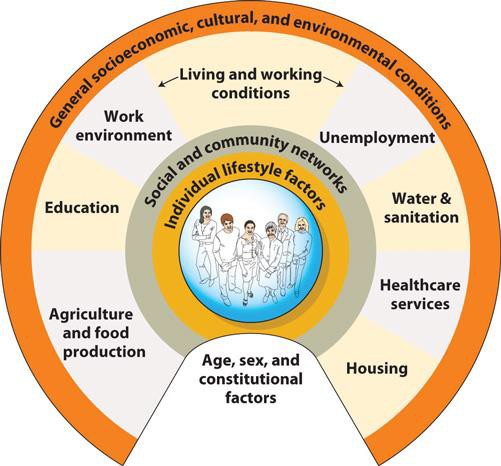Chapter 2: Achieving a Healthy Diet
2.4 National Goals for Nutrition and Health: Healthy People 2030
Video Link: Healthy People 2030
Every ten years, the U.S. Department of Health and Human Services has used public health data to establish a set of objectives and tools aimed towards improving the health and well-being of all Americans. Healthy People 2030, launched in 2020, is the fifth iteration of this program and has been updated to include new health concerns, such as vaping and Covid-19.
Similar to the Dietary Guidelines, the Healthy People program has been established to promote longer lives free of preventable disease, disability, injury, and premature death. The stated mission of Healthy People 2030 is “to promote, strengthen, and evaluate the nation’s efforts to improve the health and well-being of all people.” The goals of the program are based on the following foundational principles:[1]
- The health and well-being of all people and communities is essential to a thriving, equitable society.
- Promoting health and well-being and preventing disease are linked efforts that encompass physical, mental, and social health dimensions.
- Investing to achieve the full potential for health and well-being for all provides valuable benefits to society.
- Achieving health and well-being requires eliminating health disparities, achieving health equity, and attaining health literacy.
- Healthy physical, social, and economic environments strengthen the potential to achieve health and well-being.
- Promoting and achieving health and well-being nationwide is a shared responsibility that is distributed across the national, state, tribal, and community levels, including the public, private, and not-for-profit sectors.
- Working to attain the full potential for health and well-being of the population is a component of decision-making and policy formulation across all sectors.
The Healthy People program takes into consideration the circumstances in which people are born, live, work, and age. It also reflects the conditions that shape their circumstances such as money, power, and resources at the local, national, and global levels. Social determinants of health are primarily accountable for the lack of fair health opportunities and the unjust differences in health status that exist within and between countries.[2] The social determinants of health included in Healthy People 2030 include: economic stability, education access and quality, health care access and quality, neighborhood and built environment, and social and community context. To learn more about these social determinants of health, visit the following website: https://health.gov/healthypeople/objectives-and-data/social-determinants-health or view the “Determinants of Health” video link below.
Helping People Make Healthy Choices
It is not just ourselves, the food industry, and federal government that shape our choices of food and physical activity, but also our sex, genetics, disabilities, income, religion, culture, education, lifestyle, age, and environment. All of these factors must be addressed by organizations and individuals that seek to make changes in dietary habits. The socioeconomic model incorporates all of these factors and is used by health-promoting organizations, such as the USDA and the HHS to determine multiple avenues through which to promote healthy eating patterns, to increase levels of physical activity, and to reduce the risk of chronic disease for all Americans. Lower economic prosperity influences diet specifically by lowering food quality, decreasing food choices, and decreasing access to enough food. As a result of the 2008 financial crisis in America the number of people who struggle to have enough to eat was rising and approaching fifty million. In response to these numbers, then-USDA Secretary Tom Vilsack said, “These numbers are a wake-up call…for us to get very serious about food security and hunger, about nutrition and food safety in this country.”[3]

Video Link: Healthy People 2030 – Determinants of Health
Goals for Nutrition and Weight Status
While Healthy People 2030 has many goals and objectives, we are going to focus on the two goals related to nutrition and weight status. They are to promote health and reduce the risk of developing chronic diseases by encouraging Americans to consume healthful diets and to achieve and maintain healthy body weights. Specific objectives of Healthy People 2030 are based on solid scientific research into what behaviors and programs improve individual health and well-being. Emphasis is on modifying individual behavior patterns and habits, and having policies and environments that will support these behaviors in various settings, such as schools, work, and local community-based organizations.

Healthy People 2030 has defined the following broad, overarching goals:[4]
- Attain healthy, thriving lives and well-being free of preventable disease, disability, injury, and premature death.
- Eliminate health disparities, achieve health equity, and attain health literacy to improve the health and well-being of all.
- Create social, physical, and economic environments that promote attaining the full potential for health and well-being for all.
- Promote healthy development, healthy behaviors, and well-being across all life stages.
- Engage leadership, key constituents, and the public across multiple sectors to take action and design policies that improve the health and well-being of all.

The program has identified the following key nutrition-related recommendations:
- Consume a variety of nutrient-dense foods within and across the food groups, especially whole grains, fruits, vegetables, low-fat or fat-free milk or milk products, and lean meats and other protein sources
- Limit the intake of saturated fat and trans fats, cholesterol, added sugars, sodium (salt), and alcohol
- Limit caloric intake to meet caloric needs.[5]
Tools for Change
If you wait many hours between meals, there is a good chance you will overeat. To refrain from overeating try consuming small meals at frequent intervals throughout the day as opposed to two or three large meals. Eat until you are satisfied, not until you feel “stuffed.” Eating slowly and savoring your food allows you to both enjoy what you eat and have time to realize that you are full before you get overfull. Your stomach is about the size of your fist but it expands if you eat excessive amounts of food at one sitting. Eating smaller meals will diminish the size of your appetite over time so you will feel satisfied with smaller amounts of food.
Benefits of Following the Healthy People 2030 Goals
Nutrition and weight status are important to children’s growth and development. In addition, healthy eating habits will decrease risks for developing chronic health conditions such as obesity, malnutrition, anemia, cardiovascular disease, high blood pressure, dyslipidemia (poor lipid profiles), Type 2 diabetes, osteoporosis, dental disease, constipation, diverticular disease, and certain types of cancer.[6]

Meeting the recommended intake for energy needs by adopting a balanced eating regimen as promoted by the USDA’s My Food Plate tool will assist people in losing and maintaining weight and in improving overall health.
Objectives Related to the Healthy People 2030 Goals
Some of the objectives related to nutrition include: reducing food insecurity; increasing consumption of fruits, vegetables, and whole grains; and decreasing consumption of saturated fats and added sugars. Other objectives focus on specific micronutrients, such as increasing potassium and vitamin D consumption, decreasing sodium consumption, and reducing iron deficiency. Healthy People 2030 also focuses on preventing diseases related to nutrition and obesity, such as type 2 diabetes and cardiovascular disease. If you’d like to explore the other goals and objectives of this program, you can go to the following website: https://health.gov/healthypeople/objectives-and-data/browse-objectives.
Seven out of every ten deaths in the United States are caused by chronic diseases, such as heart disease, cancer, and diabetes, and three-quarters of the country’s health spending goes toward the cost of treating these diseases. Helping people lose weight, maintain a healthy weight, and prevent chronic disease by improving dietary habits requires providing education about food and nutrition, assuring access to healthier food options, and promoting the desire and ability to become physically active. Some of the Healthy People 2030 program’s specific related objectives are discussed below.
- Improve health, fitness, and quality of life through daily physical activity.[7] The Healthy People 2030 objectives for physical activity are based on the Physical Activity Guidelines for Americans, and reflect the strong scientific evidence supporting the benefits of physical activity. More than 80 percent of the current US population, from youth to adults, is not meeting these guidelines. Healthy People 2030 aims to increase the number of people of all ages who do both aerobic and muscle-strengthening activity. Other specific objectives include increasing the use of walking or bikes to get places, increasing participation in sports, and decreasing screen time for children and adolescents. The program also aims to increase institutional support for physical activity by increasing physical activity in child care centers, physical education in schools, and increase offerings of employee physical activity programs at workplaces. Understanding that personal, social, economic, and environmental barriers to physical activity all have a part in determining a population’s physical activity level, is an important part of being able to provide interventions that foster physical activity. Consistent physical activity is necessary for preventing chronic disease, improving bone health, decreasing body fat, and preventing an early death.
- Improve health by promoting healthy eating and making nutritious foods available.[8] Improving healthy eating includes ensuring that everyone has access to healthy foods and that people make healthy choices for what they eat. Healthy People 2030 defines food insecurity as “the disruption of food intake or eating patterns because of lack of money and other resources.”[9] Approximately 11 percent of households in the U.S. were food insecure in 2018.[10] Healthy People 2030 aims to reduce food insecurity, with a particular emphasis on children. Part of the plan for improving access to food includes increasing participation in school breakfast and summer food service programs. Specific objectives related to making healthy food choices include increasing consumption of fruits, vegetables, and whole grains; and decreasing consumption of saturated fats and added sugars. Other objectives focus on specific micronutrients, such as increasing consumption of potassium, calcium, and vitamin D; decreasing sodium consumption; and reducing iron deficiency. Healthy People also aims to increase breastfeeding of infants, reduce the availability of unhealthy foods and drinks in schools, and increase the number of employee nutrition programs offered at worksites.
- Reduce overweight and obesity by helping people eat healthy and get physical activity.[11] In addition to the physical activity and healthy eating objectives discussed above, one of the goals of Healthy People 2030 is to reduce obesity in children, adolescents, and adults. The program aims to increase the proportion of individuals who are at a healthy weight before becoming pregnant, to reduce negative outcomes associated with being overweight or underweight during pregnancy. Healthy People 2030 also focuses on preventing diseases related to nutrition and obesity, such as type 2 diabetes and cardiovascular disease.

If you would like to look through all objectives related to Healthy People 2030, including those that are not directly related to nutrition, go to the website: https://health.gov/healthypeople/objectives-and-data/browse-objectives. You can read through objectives related to specific health concerns, populations, settings, and social determinants of health.
- US Department of Health and Human Services. "Healthy People 2030 Framework." https://health.gov/healthypeople/about/healthy-people-2030-framework ↵
- World Health Organization. “Social Determinants of Health.” © 2012. http://www.who.int/social_determinants/en/. ↵
- Amy Goldstein, “Hunger a Growing Problem in America, USDA Reports,” Washington Post, 17 November 2009. http://www.washingtonpost.com/wp-dyn/content/article/2009/11/16/AR2009111601598.html. ↵
- https://health.gov/healthypeople/about/healthy-people-2030-framework ↵
- US Department of Health and Human Services. “Nutrition and Weight Status.” HealthyPeople.gov. Last updated May 1, 2012. http://healthypeople.gov/2020/topicsobjectives2020/overview.aspx?topicid=29 ↵
- National Digestive Disease Information Clearinghouse, a service of National Institute of Diabetes and Digestive and Kidney Diseases, National Institutes of Health. “Am I at Risk for Type 2 Diabetes?” NIH Publication No. 09-4805 (November 2008). Last updated December 6, 2011. http://diabetes.niddk.nih.gov/dm/pubs/riskfortype2/ [inactive]. ↵
- https://health.gov/healthypeople/objectives-and-data/browse-objectives/physical-activity ↵
- https://health.gov/healthypeople/objectives-and-data/browse-objectives/nutrition-and-healthy-eating ↵
- https://health.gov/healthypeople/objectives-and-data/social-determinants-health/literature-summaries/food-insecurity ↵
- https://health.gov/healthypeople/objectives-and-data/browse-objectives/nutrition-and-healthy-eating/reduce-household-food-insecurity-and-hunger-nws-01 ↵
- https://health.gov/healthypeople/objectives-and-data/browse-objectives/overweight-and-obesity ↵
Hunger is a physical sensation of feeling empty that is communicated to the brain by both mechanical and chemical signals from the periphery. Contrast with appetite.
Diverticulitis occurs when one or a few diverticula in the wall of your colon become inflamed.
Source - https://www.niddk.nih.gov/health-information/digestive-diseases/diverticulosis-diverticulitis
Cancer is a term used for diseases in which abnormal cells divide without control. Cancer cells can spread to other parts of the body through the blood and lymph systems. There are more than 100 kinds of cancer.
The National School Lunch Program (NSLP) and School Breakfast Program (SBP) ensure that children in elementary and middle schools receive at least one healthy meal each school day, or two if both the NSLP and SBP are provided.
Pregnancy is the development of a zygote into an embryo and then into a fetus in preparation for childbirth.

